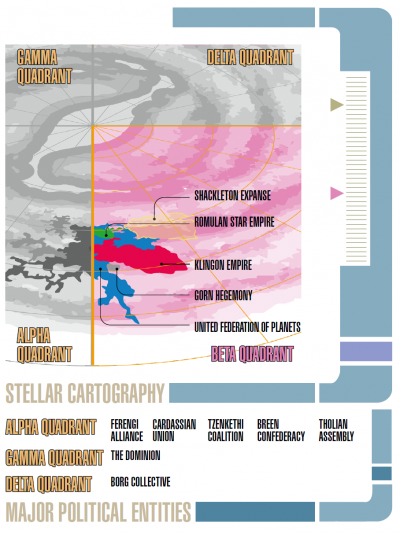Shackleton Expanse
Far from the heart of the Federation and beyond the edges of the Klingon and Romulan borders lies the Shackleton Expanse, a massive area of space deep within the Beta Quadrant. Informally named after the renowned ancient Earth explorer Ernest Shackleton, the Expanse has, as of late 2370, remained largely unexplored. The Federation Science Council and Starfleet Command have rarely committed resources to exploring the Expanse, preferring to focus on higher-priority regions closer to home. In addition, there are no reliable intelligence reports to suggest that either the Klingon Empire or the Romulan Star Empire have bothered to send reconnaissance ships or probes into the Expanse.
The existing data is a patchwork of probe telemetry, long-range sensor scans, and unreliable information and stories from independent captains and their crews who have traveled through the Expanse over the years.
History of the Expanse
The Beta Quadrant, despite housing many Federation worlds, the Romulan Star Empire, and most of the Klingon Empire, in addition to countless other unaligned systems and species, remains only barely mapped, much less explored. The most recent update from the Federation’s Stellar Cartography Society estimates that a mere 7 percent of the Beta Quadrant is fully explored, with another 5 percent mapped to some degree of confidence.
Uncertain Research
Prior to the mid-24th century, what we knew of the Expanse was largely limited to whatever reports were gathered from prospectors and independent merchants plying the trade lanes through the Beta Quadrant. Sadly, most of these reports are unreliable, thanks to the poor standards of the crews’ data gathering processes – one cannot expect a simple merchant crew to conduct science with any degree of professional objectivity or competence. Surveys and personal logs from these traders are rife with unsubstantiated reports of subspace interference, electromagnetic waveforms, tetryonic storms, and more, in addition to a litany of anecdotes that veer far from the factual and well into the fanciful. That some of these “whispers in the Expanse” or “ghost ship” stories have rooted themselves into local popular legends is a scientific pain point that quality data and objective reporting seems unable to quash.
Tall tales aside, what the reliable data tells us is that for as long as captains and their vessels have traversed parts of the Expanse, there have been regular recordings of unusually powerful gravimetric and tetryonic disturbances. These “eddies,” for lack of a better term, are unpredictable in location, size, and intensity. This would suggest that they are either naturally-occurring phenomena, or possibly the product of an incredibly advanced and capricious alien mind.
If reports are to be believed, several transports and merchant freighters have been lost over the last several decades due to run-ins with these spatial phenomena. The phenomena are powerful enough to disrupt ship systems and even overload or destroy vessels unfortunate enough to get too close or foolish enough to investigate without taking precautions.
Sector and Planetary Surveys
The quantity and quality of data regarding the myriad solar systems and planets contained within the Expanse are likewise limited in scope and accuracy. No formal effort on the part of any known polity has attempted to map the Expanse. What information we do have about reliable space lanes and navigational hazards has been cobbled together over the last century or more by those same independent merchants mentioned earlier.
Long-range sensors and existing probe data indicate that the Expanse is packed with resource rich systems, planets, moons, and asteroid belts of all types, along with countless stellar phenomena and fixtures worthy of study. As word of these facts leak out into the Galaxy, e a “gold rush” mentality could bring any number of species and ships to Narendra Station and to the Shackleton Expanse.
The Expanse encompasses a vast section of the Beta Quadrant, a sprawl of territory along the feathered edges of the Orion Spur of the Milky Way. Thousands of stars and star clusters are located within the Expanse, along with countless planets, planetoids, and stellar bodies of all shapes and sizes. We can only guess at how many sentient lifeforms or organized civilizations are contained within the Expanse. As a matter of anthropological interest, no known sentient species has claimed to hail from a world contained within the boundaries of the Expanse. One would think that such a large area of space would have generated at least a handful of talkative species willing to point us toward their home and to give us another clue about the Expanse, but no such luck. They’re either unwilling or unable to share that information with us, or perhaps we’re just not looking in the right places or asking the right questions.
